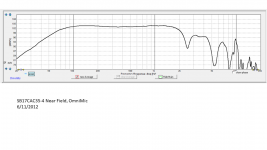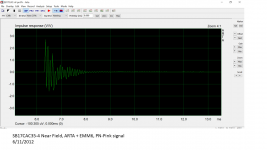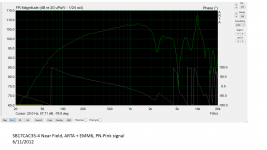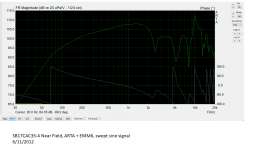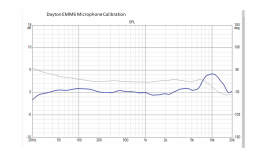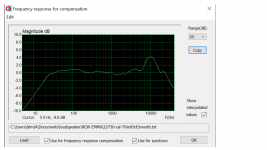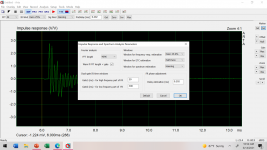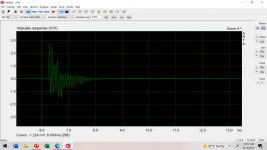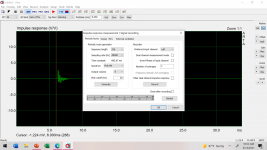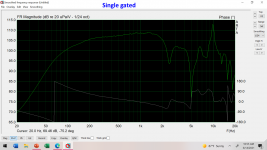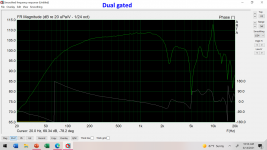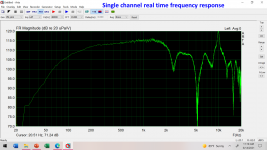Member
Joined 2003
There is no mistake, the phase is accurate to the start of the FFT window. Simply move the window start cursor ahead to see the phase "unwrap", and you will probably find that it will match the Clio system closely when you locate the cursor at the peak of the impulse rather than behind it.
Of course if you are making multiple measurements and want to keep accurate delay information, the "excess phase" is not a problem, simply keep the same window start position for all measurements that is behind the impulse and the delays will be included in the measured data.
Of course if you are making multiple measurements and want to keep accurate delay information, the "excess phase" is not a problem, simply keep the same window start position for all measurements that is behind the impulse and the delays will be included in the measured data.
Last edited:
For example VituixCAD has compensation for this delay, on Drivers tab on the main program right below the frequencyresponses list "Delay". As long as the delay is constant accross all measurements you intend to use in simulation it is ok to unwrap the phase with that, I think.
You put the left cursor before the impulse.
Then you put the right cursor to the peak value of the impulse. Use the zoom to find it easily.
Then you press "Get" (next to predelay) and the value is inserted.
Then you move the right cursor where you want for the gating. Don't move the left cursor.
That's it.
Then you put the right cursor to the peak value of the impulse. Use the zoom to find it easily.
Then you press "Get" (next to predelay) and the value is inserted.
Then you move the right cursor where you want for the gating. Don't move the left cursor.
That's it.
Near Field measurement Help Needed
I seem to be doing something wrong when I make Near Field low frequency measurements. I am not sure if the mistake is in the way I capture the impulse response (*.pir file), or in the way I process the impulse into a frequency/phase response curve.
I am measuring an SB17CAC35 6” midbass driver in a 10 liter sealed box. The Dayton EMM6 microphone is about 10 mm from the center of the dustcap.
The first plot is the near field response I measure with OmniMic. This is exactly what I would expect.
The second plot is the impulse response I measure with ARTA + EMM6 using PN-Pink signal. The third plot is the Dual-Gate FR/phase measurement. I also repeated the FR measurement with a swept sine signal and got very similar results (fourth plot).
The two ARTA FR plots do not look like 2-pi responses. They look more like a 4-pi response. ??? I know I am doing something wrong, but I am struggling to identify my error.
I should add that my far-field gated responses with ARTA+EMM6 match my OmniMic responses, to within the calibration tolerances of both microphones.
Any thoughts or advice would be most welcome… Jim
I seem to be doing something wrong when I make Near Field low frequency measurements. I am not sure if the mistake is in the way I capture the impulse response (*.pir file), or in the way I process the impulse into a frequency/phase response curve.
I am measuring an SB17CAC35 6” midbass driver in a 10 liter sealed box. The Dayton EMM6 microphone is about 10 mm from the center of the dustcap.
The first plot is the near field response I measure with OmniMic. This is exactly what I would expect.
The second plot is the impulse response I measure with ARTA + EMM6 using PN-Pink signal. The third plot is the Dual-Gate FR/phase measurement. I also repeated the FR measurement with a swept sine signal and got very similar results (fourth plot).
The two ARTA FR plots do not look like 2-pi responses. They look more like a 4-pi response. ??? I know I am doing something wrong, but I am struggling to identify my error.
I should add that my far-field gated responses with ARTA+EMM6 match my OmniMic responses, to within the calibration tolerances of both microphones.
Any thoughts or advice would be most welcome… Jim
Attachments
This information may help:
Q: Why ARTA is showing impulse response with "zero time" shifted to sample position 300?
A: Modern digital systems often use some kind of finite impulse response (FIR) filtering or equalization. Such kind of filtering introduce predelay (or pre-ringing) in impulse response (IR). The predelay usually uses from 64 to 256 samples. To see effects of digital filter predelay, ARTA shifts "zero time" to sample position 300.
In the single channel mode, zero time is undefined as PC-soundcard latency is not constant. Then ARTA shifts IR in a way that position od IR maximum is close to sample position 300.
This means that single channel mode IR measurements can't be used for absolute delay ("time of flight") estimation.
Q: Why ARTA is showing impulse response with "zero time" shifted to sample position 300?
A: Modern digital systems often use some kind of finite impulse response (FIR) filtering or equalization. Such kind of filtering introduce predelay (or pre-ringing) in impulse response (IR). The predelay usually uses from 64 to 256 samples. To see effects of digital filter predelay, ARTA shifts "zero time" to sample position 300.
In the single channel mode, zero time is undefined as PC-soundcard latency is not constant. Then ARTA shifts IR in a way that position od IR maximum is close to sample position 300.
This means that single channel mode IR measurements can't be used for absolute delay ("time of flight") estimation.
gdan - This is from ARTA... And thank you for helping out 
JMB - The information you posted is something I was only vaguely aware of, thanks... Do you think that I am making a timing / windowing error? I am doing a dual-channel measurement. I have tried setting the cursor at the start of the pre-ringing, and at the start of the impulse and I get the same result.
JMB - The information you posted is something I was only vaguely aware of, thanks... Do you think that I am making a timing / windowing error? I am doing a dual-channel measurement. I have tried setting the cursor at the start of the pre-ringing, and at the start of the impulse and I get the same result.
Attachments
You can do single or double channel measurements for the Nearfield as the phase is not really of consequence since you will be splicing the amplitude response and not setting a crossover at the level of the NF measurement. The important thing is to be able to capture the entire amplitude response.
I am still not getting a valid near field measurement. I made some screen shots of ARTA throughout the process.
1 - setting up the impulse response. This is a single channel setup.
2 - the resulting impulse with the mic 1/4 inch from the center of the dust cap. The pre-delay was set from the start of the pre-ringing to the peak.
3 - the IR and spectrum analysis parameters window
4 - the single gated frequency response
5 - the dual gated frequency response
6 - This is interesting, this is the real time frequency response using periodic pink noise. I do not see how any timing / gating error plays into this response curve, and yet it shows the same -10 dB drop from 1000 Hz down to 100 Hz.
Could this be a microphone problem? I was under the impression that calibration issues were usually above 1 kHz...
Hopefully someone spots a goofed up setting or some other dumb-*** mistake I am making...
J.
1 - setting up the impulse response. This is a single channel setup.
2 - the resulting impulse with the mic 1/4 inch from the center of the dust cap. The pre-delay was set from the start of the pre-ringing to the peak.
3 - the IR and spectrum analysis parameters window
4 - the single gated frequency response
5 - the dual gated frequency response
6 - This is interesting, this is the real time frequency response using periodic pink noise. I do not see how any timing / gating error plays into this response curve, and yet it shows the same -10 dB drop from 1000 Hz down to 100 Hz.
Could this be a microphone problem? I was under the impression that calibration issues were usually above 1 kHz...
Hopefully someone spots a goofed up setting or some other dumb-*** mistake I am making...
J.
Attachments
With the dual gate measurement, gate 1 is 20 ms, gate 2 is 300 ms.
With the single gate measurement, I set the cursor at the start of the pre-ringing, and ARTA is supposed to take as much the signal as it can. If I were using swept sine signal, this would not work... I would have to select a gate window that would be compatible with the signal length and the FFT size... but if I understand the documentation, with PN Pink signal, all I need to do is set the cursor at the start of the pre-ringing...
Am I confused?
With the single gate measurement, I set the cursor at the start of the pre-ringing, and ARTA is supposed to take as much the signal as it can. If I were using swept sine signal, this would not work... I would have to select a gate window that would be compatible with the signal length and the FFT size... but if I understand the documentation, with PN Pink signal, all I need to do is set the cursor at the start of the pre-ringing...
Am I confused?
Hi Jim,
I have just looked at your discussion.
Here are my suggestions:
When you measuring bass in near field use larger sequences (64k is ok).
Averaging is not needed when using swept sine.
Use larger FFT in analysis (8k min).
Do not use gating (no need for that).
Driver has to be mounted in box or in large baffle.
Microphone has to measure large pressure, so you must assure it is not clipping (check by comparing response with response measured with smaller power.
Check if input amplifier is overloaded.
Check if your mic. preamplifier has hi-pass filtering turned on.
Is your phantom powering gives enough power to mic.
Best,
Ivo
I have just looked at your discussion.
Here are my suggestions:
When you measuring bass in near field use larger sequences (64k is ok).
Averaging is not needed when using swept sine.
Use larger FFT in analysis (8k min).
Do not use gating (no need for that).
Driver has to be mounted in box or in large baffle.
Microphone has to measure large pressure, so you must assure it is not clipping (check by comparing response with response measured with smaller power.
Check if input amplifier is overloaded.
Check if your mic. preamplifier has hi-pass filtering turned on.
Is your phantom powering gives enough power to mic.
Best,
Ivo




